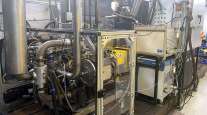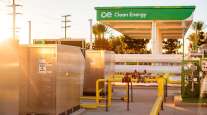U.S. Could Spend $340 Million for Natural Gas Tax Incentives
This story appears in the Feb. 18 print edition of Transport Topics.
The U.S. government could give out $340 million in refunds this year under a tax incentive program that helps boost the use of natural gas as a transportation fuel, according to an estimate by Congress’ Joint Committee on Taxation.
Congress cleared the way for the refunds when it passed the tax measure known as the “fiscal cliff” bill at the start of 2013.
The bill renewed an expired 50-cent tax credit per gasoline-gallon equivalent of compressed natural gas and a 50-cent credit per gallon of liquefied natural gas. Whoever owns the natural gas put into a vehicle earns the tax credit.
A second program allows for a tax credit of up to $30,000 for investing in a natural-gas fueling station or for adding equipment there.
In addition to restarting the credits, Congress agreed to make all of them retroactive to 2012; the fuel credits had expired at the end of 2011.“The credits make [natural gas] less expensive and even more attractive to truckers,” said Glen Kedzie, vice president for environmental affairs and assistant general counsel for American Trucking Associations.
“We’re going to have a great year anyway; this is going to make the growth even faster,” said Richard Kolodziej, president of NGVAmerica, the national coalition of natural-gas advocates, producers and users.
Fleets that build their own fueling facilities and then fill their trucks are eligible for both the 50-cent credit and the infrastructure credit, he said.
In an earlier interview with Transport Topics, Kolodziej said it was not unusual for fleets to negotiate the price they have to pay for natural gas fuel by pointing out to the retailers that the retailers get to reap a tax credit for every gallon they sell.
The tax committee’s $340 million figure includes estimates on the retroactive tax credits the U.S. Treasury will pay out during 2013.
Richard Wheeler, chief financial officer of Clean Energy Fuels Corp., said the tax credits provide “another impetus for people to make the decision and, perhaps, pull the trigger on buying some trucks and . . . seeing how a natural-gas vehicle works.”
Infrastructure is still a big hurdle for the expansion of natural gas use, however.
The $30,000 tax credit for infrastructure is not likely to be the deciding factor for a fleet weighing whether to abandon diesel, said ATA’s Kedzie. “These individual refueling lanes can run around $1 million plus, so, $30,000 is really a drop in the bucket, but it is something to help them,” he said.
The tax credits, which will expire at the end of 2013 unless renewed, have been around, off and on, since 2005. When first created, they lasted until 2009. Congress then let them lapse, renewed them for one year and let them expire again in 2011.
Congress’ unwillingness to give longer life to the credits makes them less effective than they could be, a fleet executive said.
“You can’t figure it into your payback if it’s not going to be there,” said Anna Deal, coordinator of “green” initiatives for Lynden Inc., an Alaska-based carrier.
“It sort of just becomes a bonus for folks who are already planning on [converting to natural gas],” said Deal, who works at the Alaska headquarters of Lynden, which runs in the Pacific Northwest.
Deal worked on a joint project between Lynden and the National Energy Policy Institute at Tulsa University to identify issues facing fleets transitioning from diesel to natural gas. She was a speaker at ATA’s recent Natural Gas Summit.
The Treasury Department also provided TT with historical figures that show how much the 50-cent-a-gallon tax credit has grown.
During fiscal 2007, the first year the government began processing claims, $70 million worth of credits were paid out for the 50-cent credit, Treasury said. The department noted that includes some credits for propane use.
Two years later, that figure had surged to $290 million.
Figures for the $30,000 property investment credit are not as specific because the tax forms do not ask companies to specify which alternative fuel they are using.
Treasury did say that about $18 million in credits were earned by those investing in alternative-fuel filling stations and equipment in 2010.




